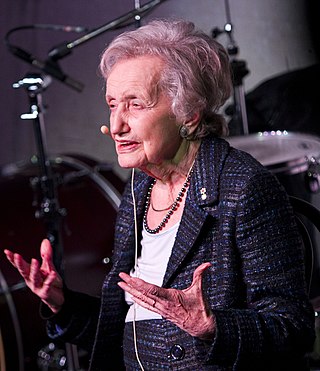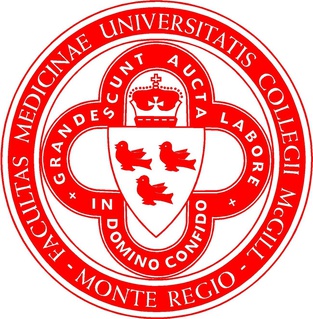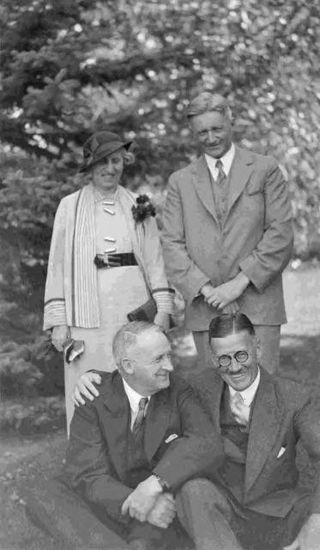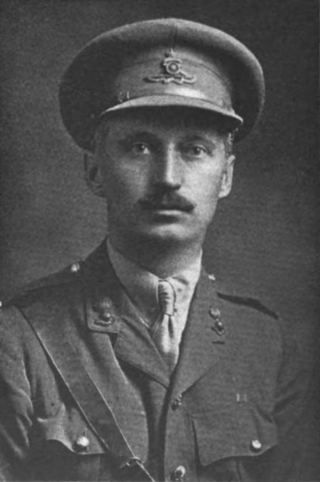Related Research Articles

Brenda Milner is a British-Canadian neuropsychologist who has contributed extensively to the research literature on various topics in the field of clinical neuropsychology. Milner is a professor in the Department of Neurology and Neurosurgery at McGill University and a professor of Psychology at the Montreal Neurological Institute. As of 2020, she holds more than 25 honorary degrees and she continued to work in her nineties. Her current work covers many aspects of neuropsychology including her lifelong interest in the involvement of the temporal lobes in episodic memory. She is sometimes referred to as the founder of neuropsychology and has been essential in its development. She received the Balzan Prize for Cognitive Neuroscience in 2009, and the Kavli Prize in Neuroscience, together with John O'Keefe, and Marcus E. Raichle, in 2014. She turned 100 in July 2018 and at the time was still overseeing the work of researchers.
George William Humphrey FRSC was a British psychologist, author, and philosopher. He was the founder of the Canadian Psychological Association, the first Director of the Institute of Experimental Psychology, and Professor of Psychology at the University of Oxford. Humphrey's research concentrated on behavioral studies such as reinforcement, habituation, and apparent movements, as well as psychophysical topics like audiogenic seizures. He is known for Humphrey's Law.
Alfred Ernest Whitehead was an English-born Canadian composer, organist, choirmaster, music educator, painter, whose works are held in a number of important private collections, and an internationally recognized authority in the field of philately. His The Squared-Circle Cancellations of Canada received its third edition shortly after his death.

Robert Tait McKenzie was a Canadian physician, educator, sculptor, athlete, soldier and Scouter. Born in Ramsay Township, Lanark County, Ontario, Canada, he attended McGill University in Montreal as an undergraduate and medical student, and was an instructor in its medical school beginning in 1894. In 1904, he moved to the United States to teach at the University of Pennsylvania in Philadelphia, Pennsylvania. In the 1930s, he returned to the county of his birth, retiring to the Mill of Kintail in Almonte.

The Faculty of Medicine and Health Sciences is one of the constituent faculties of McGill University. It was established in 1829 after the Montreal Medical Institution was incorporated into McGill College as the college's first faculty; it was the first medical faculty to be established in Canada. The Faculty awarded McGill's first degree, and Canada's first medical degree to William Leslie Logie in 1833.

John Malcolm MacEachran was a Canadian philosopher and psychologist, whose most notable credentials involved the development of the Psychology and Philosophy Department at the University of Alberta. He was a co-founder of the Canadian Psychological Association and the appointed Chairman of the Alberta Eugenics Board which was responsible for approving the sterilization of thousands of Albertans, hundreds of which were without consent.
Cyrus Macmillan, was a Canadian academic, writer and politician.
Zenon Walter Pylyshyn was a Canadian cognitive scientist and philosopher. He was a Canada Council Senior Fellow from 1963 to 1964.
The study and teaching of philosophy in Canada date from the time of New France. Generally, Canadian philosophers have not developed unique forms of philosophical thought; rather, Canadian philosophers have reflected particular views of established European and later American schools of philosophical thought, be it Thomism, Objective Idealism, or Scottish Common Sense Realism. Since the mid-twentieth century the depth and scope of philosophical activity in Canada has increased dramatically. This article focuses on the evolution of epistemology, logic, the philosophy of mind, metaphysics, ethics and metaethics, and continental philosophy in Canada.

Terence William Leighton MacDermot was a Canadian diplomat and academic.

Boris Petrovitch Babkin FRS, M.D., D.Sc, LL.D was a Russian-born physiologist, who worked in Russia, England and Canada.

William Campbell James Meredith (1904–1960), often referred to as W. C. J. Meredith, was a Canadian lawyer, the author of three legal texts, and Dean of the McGill University Faculty of Law (1950–1960). In 1951, he was noted for the prescient hiring of John Cobb Cooper to head up the new department he created, McGill's Institute of Air Space Law.
Jonathan Campbell Meakins was a Canadian physician and medical author and member of the Canadian Medical Hall of Fame. In authorship he is known as J. C. Meakins. He published over 160 works, including the textbook The Practice of Medicine. He was also the founder and first president of the Royal College of Physicians and Surgeons of Canada. He was the Dean of the McGill University's Faculty of Medicine from 1941-48.

Horst Oertel M.D., Emeritus Professor and Head of Pathology at McGill University, Montreal (1918–1938), he was well-known on both sides of the Atlantic. Five of his books are still published today as standard texts for students of Pathology.

The McCall MacBain Arts Building is a landmark building located at 853 Sherbrooke Street West in Montreal, Quebec, in the centre of McGill University's downtown campus. The Arts Building is the oldest existing building on campus, and it was designed in the Classical Revival style by John Ostell. Construction began in 1839, and the building's central block and east wing were completed in 1843. The west and north wings were finished in 1861 and 1925, respectively, after involving multiple architects, including Alexander Francis Dunlop and Harold Lea Fetherstonhaugh. Today, the Arts Building is made up of a central block and three distinct wings – Dawson Hall (east), Molson Hall (west) and Moyse Hall (north). The building currently houses the Department of French Language and Literature, the Department of English, and the Department of Art History and Communication Studies. It also hosts lectures for several other departments from the Faculty of Arts.

Lieutenant Colonel Edmund Graves Meredith Cape, DSO was the founding president of E.G.M. Cape & Co., Engineers and Contractors of Montreal, and a governor of the Montreal General Hospital. He raised and commanded the 3rd Battery, Canadian Siege Artillery, and was later appointed commanding officer of the 2nd Medium Brigade, Royal Regiment of Canadian Artillery. His home on Redpath Crescent was one of the last houses put up in the Golden Square Mile.
Abraham Aaron Roback (1890–1965) was a Jewish American psychologist and promoter of Yiddish.
John Tait was a 20th-century Scottish physician, physiologist and medical author. He was emeritus Professor of Medicine at McGill University in Canada.
Terence J. Coderre is Professor of Medicine and the Harold Griffith Chair in Anaesthesia Research at McGill University in Montreal, Quebec, Canada. He is an investigator at the Alan Edwards Centre for Research on Pain at McGill University and the McGill University Health Centre Research Institute in Brain Repair and Integrative Neuroscience (BRaIN) Program.

John Clark Murray was a Scottish-Canadian philosopher and professor. He held the Chair of Mental and Moral Philosophy at Queen's University from 1862 to 1872, and at McGill University from 1872 until 1903. During his academic career, Murray became the first professor at Queen's to offer courses to women; however, his equality advocacy caused unrest among the male professors. He was married to Margaret Polson Murray who founded the Imperial Order Daughters of the Empire.
References
- ↑ Bazar, J. L. & Green, C. D. (2021). How Canada's first psychology department arose at McGill University. Canadian Psychology, 63(1), 149–160. https://doi.org/10.1037/cap0000238
- ↑ Frost, Stanley Brice (1980). McGill University: For the Advancement of Learning, Volume II, 1895-1971. McGill-Queen's University Press.
- ↑ Smol, Robert (May 26, 2017). "THE MAJILLSES GO TO WAR: McGill University's 7th Siege Battery At Vimy". Esprit de Corps. Retrieved December 10, 2020.
- ↑ Bell, Don (2005). The Man Who Killed Houdini. Véhicule Press.
- ↑ Tait, William Dunlop. (1929). Science and education. The Scientific Monthly, 29(2), 132-136.